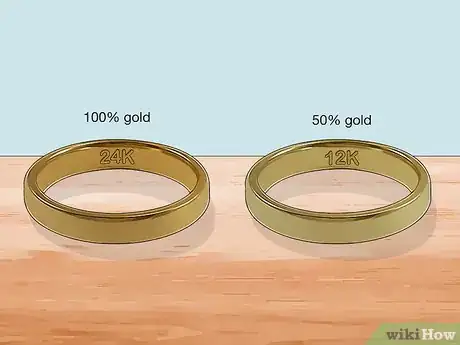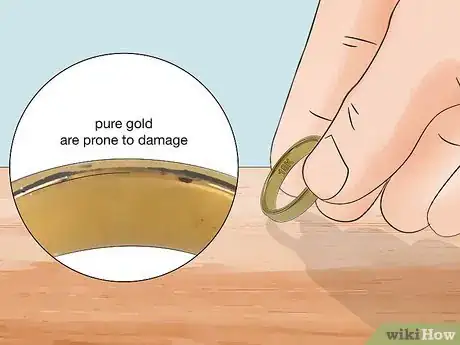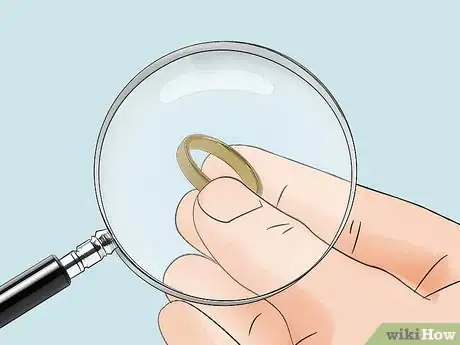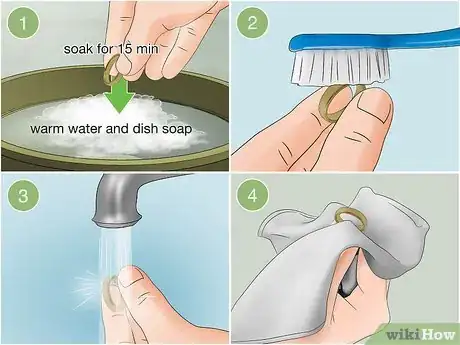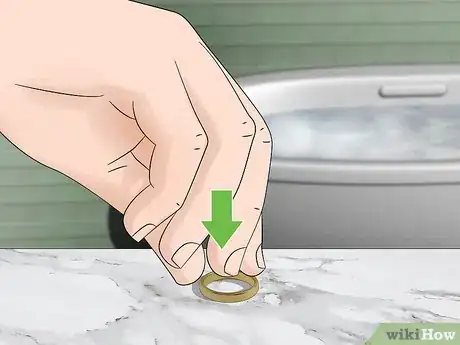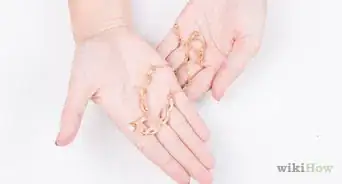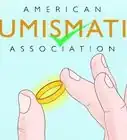This article was co-authored by Kennon Young. Kennon Young is a Gemological Institute of America (GIA) Graduate Gemologist, an American Society of Appraisers (ASA) Master Gemologist Appraiser, and a Jewelers of America (JA) Certified Bench Jeweler Technician. He received the highest credential in the jewelry appraisal industry, the ASA Master Gemologist Appraiser, in 2016.
There are 15 references cited in this article, which can be found at the bottom of the page.
wikiHow marks an article as reader-approved once it receives enough positive feedback. In this case, 100% of readers who voted found the article helpful, earning it our reader-approved status.
This article has been viewed 206,182 times.
Whether you are shopping for a special occasion or treating yourself, purchasing gold jewelry can be a delightful experience. Gold is a precious metal that retains its value. It is also durable and will last indefinitely with proper care. However, buying gold jewelry can also be expensive. The price of gold varies greatly, depending on weight, karat and where you make your purchase. Because this special purchase is an investment that can last a lifetime, research your jewelry and buy wisely in order to find and keep quality pieces that will bring years of enjoyment.
Steps
Researching Gold Jewelry
-
1Familiarize yourself with purity standards. The value of gold is determined by its purity, also known as ‘fineness.' This is measured in karats. The karat measurement divides purity into 24ths. For example, 24 karat gold is 100 percent pure and 12 karat gold is 50 percent pure.[1]
-
2Determine the right purity for you. While gold is generally more valuable at higher levels of purity, you or the person you are purchasing the jewelry for may prefer less pure gold for practical reasons. 24 karat gold is very soft and highly prone to scratching and damage.[2] Of course, pure gold is also vastly more expensive than alloyed gold.
- If you plan on wearing the jewelry on a daily basis, you will probably want it to be no more than 18 karats, i.e. 75 percent pure, to avoid damage.[3]
- You should also consider how often your jewelry will come into contact with hard surfaces on a regular basis. For example, highly pure gold rings and bracelets are likely to experience damage if worn daily.
Advertisement -
3Consider plated or vermeil gold. Plated and vermeil describe methods of dipping other metals into molten gold to create a coating. This jewelry will be cheaper than the purer varieties but also more prone to cracking and wear.
- Plating involves dipping a base metal like steel or brass into an electroplating solution with a lump of pure gold. An electric current is applied and the gold will attach itself in a thin layer around the metal. The plating is usually very thin and prone to wear.[4]
- Vermeil involves the same plating process but specifically refers to jewelry that has a base material of sterling silver. Sterling silvery is often preferred by people that have allergies to precious medals. The plating is usually very thin and prone to wear.
-
4Pick your color. Gold typically comes in yellow, pink, and white. There is also a rarer green variety. The pink, white, and green varieties are created by mixing gold with other metals. The non-yellow varieties are usually no more than 18 karats.[5]
- Yellow gold represents the color of the natural color of the mineral but that doesn’t mean that all yellow gold jewelry is pure. Don’t assume that yellow gold is pure and always check the markings.[6]
- White gold is created by mixing in palladium or nickel. It resembles silver but has a slightly brighter hue.
- Pink or rose gold is created by mixing in copper.
- Green gold is created by mixing in silver. Because of the value of both silver and gold, green gold is usually more expensive than other varieties.
Purchasing Your Jewelry
-
1Find a reputable dealer. The large national outlets like Nordstroms, Zales, Jared’s, and Sarraf are the most trustworthy in terms of quality but often include significant markups and similar pieces can be found for less at independent dealers.[7] If you do look for an independent dealer, make sure to do your research and make sure they are reputable.
- Don’t be afraid to ask a potential jeweler for their credentials and proof of certification.
- Pick a jeweler that offers a variety of services such as resizing and custom design.
- If it’s a significant purchase, don’t buy at the first store you visit. Look for similar pieces at other stores so you have a price comparison.
- Check the current price of gold by the ounce to make sure you're getting a good deal.[8]
-
2Ask about a warranty. Reputable jewelers typically offer warranties and some kind of return policy. Warranties will add to the cost but may be a good idea for an expensive piece or one that is made of highly pure gold, because of the risk of damage. Make sure to ask about this before your purchase.
-
3Check the markings. Gold jewelry will have a hallmark signifying that it is real gold and other aspects of the quality. The marking is usually in an inconspicuous place like the inside of a ring or on the ear-facing side of an earring. Ask your jeweler where the hallmarks are if you’re having trouble finding them.
- The markings will demonstrate purity in one of two ways. Some will show the number of karats with the letter ‘K’ after it. For example, ‘24K’ means 24 karat pure gold. Some gold pieces will instead have a three digit number that expresses the percentage of purity to the tenth decimal point. For example, 14 karat gold might say ‘585,’ which means that it’s 58.5 percent pure and 8 karat gold might say ‘333,’ which means it’s one-third pure.[9]
- Beyond the purity, there should also be a marking to indicate the additive metal for impure alloyed gold. ‘GF’ means gold filled, ‘GP’ means gold plated. To express the base metal, ‘Pd’ means Palladium, ‘PT’ or ‘PLAT’ means platinum and ‘SS’ or ‘STEEL’ means stainless steel.[10]
- There may also be a single or double-digit marking for the ring size if it’s a ring.
-
4Have it independently inspected. If it’s an exceptionally expensive purchase or if you have any doubts about the quality, you may want to have the jewelry independently verified. Take the jewelry to a different store and pay a certified jeweler to examine and appraise the piece.[11]
-
5Beware of scams. US laws requires the karat value trademarks which should help you avoid scams.[12] If you are purchasing gold jewelry online, make sure that at least one of the pictures displays the trademarks and ask for one from the seller if they do not.
- Research the typical price of your gold piece accounting for the purity. Watch out for gold that is extremely cheap as it may be counterfeit or have false markings.[13]
Maintaining Gold Jewelry
-
1Clean it periodically. Gold jewelry wears and collect dirt easily so it should be cleaned regularly. If you wear the jewelry every day, clean it at least once every other month.[14] You’ll need two bowls of warm water, dishwashing soap, a lint-free cloth, and a toothbrush.[15]
- Add a few drops of dishwashing soap to a large bowl filled with warm water. Gently place the jewelry in the water and let it soak for about 15 minutes.
- Pick up the jewelry and scrub it with the toothbrush. Pay special attention to the crevices where dirt can collect.
- Rinse the jewelry in the water bowl without the soap. Make sure you remove all soap residue.
- Gently blot the jewelry dry with a soft, lint-free cloth. Place the jewelry on the cloth and let it air dry for about 20 minutes.
-
2Store it properly. Gold jewelry easily collects dust, especially pieces with a lot of crevices.[16] If you aren’t wearing the jewelry on a daily basis, keep it in a small jewelry box.
- Try to keep it separate from other jewelry pieces that might cause scratching on contact.
-
3Take it off when bathing. Gold jewelry will collect soap residue and potentially wear from hot water in a shower so make sure to take it off before bathing. Place is in a soft cloth where it won’t be damaged.
Expert Q&A
-
QuestionHow do you determine the value of gold jewelry?
 Kennon YoungKennon Young is a Gemological Institute of America (GIA) Graduate Gemologist, an American Society of Appraisers (ASA) Master Gemologist Appraiser, and a Jewelers of America (JA) Certified Bench Jeweler Technician. He received the highest credential in the jewelry appraisal industry, the ASA Master Gemologist Appraiser, in 2016.
Kennon YoungKennon Young is a Gemological Institute of America (GIA) Graduate Gemologist, an American Society of Appraisers (ASA) Master Gemologist Appraiser, and a Jewelers of America (JA) Certified Bench Jeweler Technician. He received the highest credential in the jewelry appraisal industry, the ASA Master Gemologist Appraiser, in 2016.
Certified Jewelry Appraiser Europe uses parts per thousand for purity standards. So a piece that's labeled "750" is 75% pure gold. If you see a stamp that says "GF" which means "gold filled" or if you notice green oxidization on the surface, the gold jewelry may be fake.
Europe uses parts per thousand for purity standards. So a piece that's labeled "750" is 75% pure gold. If you see a stamp that says "GF" which means "gold filled" or if you notice green oxidization on the surface, the gold jewelry may be fake.
References
- ↑ www.bluenile.com/education/metal/gold
- ↑ www.callagold.com/education/gold-jewelry-alloys/
- ↑ https://blog.brilliance.com/education/14k-vs-18k-gold
- ↑ https://www.thermofisher.com/blog/metals/how-gold-plating-is-done-step-by-step/
- ↑ jewelrygenius.com/rosegld2.html
- ↑ www.finishing.com/faqs/whitegold.shtml
- ↑ https://www.consumeraffairs.com/finance/gold-dealers/
- ↑ Kennon Young. Master Gemologist Appraiser. Expert Interview. 13 September 2019.
- ↑ https://bellatory.com/fashion-accessories/750-585-417-gold-markings-jewelry
- ↑ www.raregoldjewelry.com/guide-stamps-inscriptions-gold-jewelry
- ↑ www.diamondreview.com/tutorials/independent-appraisal
- ↑ http://laneysjewelry.com/jewelry_scams.htm#_Toc407100095
- ↑ www.jewelrynotes.com/how-to-detect-fake-gold-chain-necklace/
- ↑ Kennon Young. Master Gemologist Appraiser. Expert Interview. 13 September 2019.
- ↑ www.realsimple.com/beauty-fashion/.../jewelry/clean-gold-jewelry
- ↑ www.blingjewelry.com/jewelry-care-i-16.html
About This Article
To buy gold jewelry, start by finding a reputable dealer who has proof of certification. Then, look at the markings on any pieces you’re interested in. Check the gold’s purity, which will be marked with a number and the letter K to indicate how many karats it is, or a 3-digit number that tells you the percentage of purity to the tenth decimal. Additionally, take note of any markings that indicate that the gold isn’t pure, like “GF,” which means gold-filled. You should also ask about a warranty before you buy anything, and consider an independent inspection. For tips on choosing what color and quality gold jewelry to buy, scroll down!
